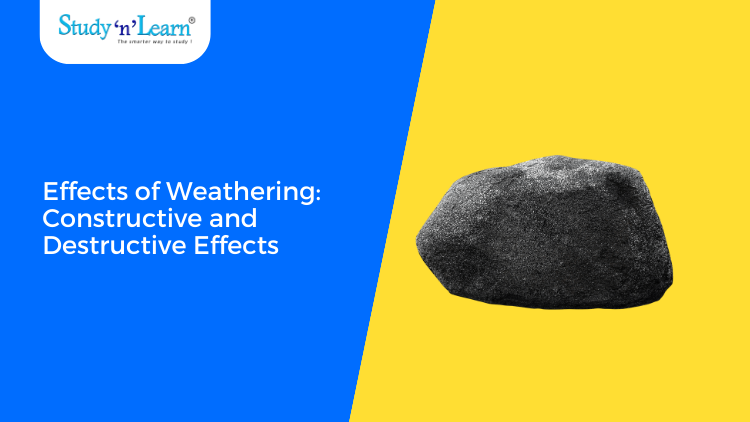
What is weathering?
The wearing away or break down of rocks by agents present in the atmosphere like temperature, moisture and frost are known as weathering. Let us learn about the effects of weathering!
Effects Of Weathering
The process of weathering refers to the breakdown and alteration of rocks and minerals due to exposure to the elements. This natural process is a result of physical, chemical, and biological forces and can have several effects on the environment. In this brief, we will discuss the effects of weathering on the landscape, soil, and living organisms.
One of the most visible effects of weathering is the alteration of the landscape. Over time, weathering can erode mountains, create valleys and canyons, and shape the earth's surface. Weathering can also cause the formation of unique geological formations, such as rock arches and pillars. This process of weathering is particularly evident in areas with extreme temperatures or heavy rainfall.
Another significant effect of weathering is the impact it has on soil quality. Weathering can break down rocks and minerals into smaller particles, which can mix with organic matter to create fertile soil. This can lead to the growth of plants, which in turn can support a variety of living organisms. Weathering can also lead to the accumulation of minerals in the soil, which can be beneficial for agriculture.
In addition to affecting the landscape and soil, weathering can also have an impact on living organisms. For example, weathering can create new habitats for plants and animals, which can support diverse ecosystems. Weathering can also release nutrients and minerals into the environment, which can be utilized by organisms as a source of food and energy.
Finally, it is important to note that weathering can also have negative effects. Weathering can contribute to the erosion of buildings and infrastructure, as well as the degradation of cultural artifacts and historical sites. Additionally, weathering can contribute to the release of harmful minerals and chemicals into the environment, which can be harmful to living organisms.
How does weathering affect the Earth's surface?
The decomposition and disintegration of rocks bring about a lot of changes on the Earth's surface. These changes can be constructive as well as destructive.
Constructive Effects of Weathering
(i) Weathering leads to soil formation which is required for agriculture.
(ii) The weathering process leads to exposure to new minerals which become easy to be exploited, e.g. chemical weathering gives rise to many new minerals having economic value.
(iii) Weathering may provide new landscape, e.g. Karst topography.
But what is Karst topography?
This is a type of landscape that is formed when water dissolves and erodes soft rock (like limestone) and leaves behind landscapes such as caves, surface sinkholes, and tall, steep rock cliffs.
(iv) Weathering may provide building materials like cement and limestones.
(v) The weathered rock material is very useful in the process of soil formation and can also expose mineral deposits.
(vi) Continuous removal and transfer of disintegrated and decomposed rocks through landslides, rockfall, rock slides, etc. can cause lowering of the height of the affected areas and also help in the evolution and formation of various landforms.
Destructive Effects of Weathering
(i) Mechanical weathering may cause extensive soil erosion, which may affect agriculture.
(ii) Landslides may cause havoc in mountainous areas.
(iii) Chemical weathering may dissolve the soluble components of the soil or wash away the topmost layer of the soil. This brings difficulty in agriculture and other economic activities.
What do you think, why does it affect agriculture? The top layer of the soil is the most fertile one. The soil loses its fertility when the topmost layer is washed away.
(iv) In high altitude regions weathering causes icebergs to slide down the slopes into the valleys. They put obstacles in the sailing of boats and steamers.
(v) Rocks are disintegrated and decomposed due to the work of different processes of weathering. They produce a large amount of rock waste. Normally the wastes lie over the unweathered fresh rock and are called regoliths.
(vi) Weathering can cause damage to human settlements in the foothill zones when the mass movement of rock waste comes down the hill slopes. We know the case of Kedarnath in Uttarakhand. It can also obstruct the river channel and may form lakes.
(vii) The rapid rate of weathering, due to deforestation in hilly areas, can cause the overloading of rivers and retard their flow. This can also cause a rapid rate of siltation of river beds.
In conclusion, the effects of weathering are numerous and diverse. While weathering can create beautiful landscapes, support fertile soil, and promote diverse ecosystems, it can also lead to the erosion of infrastructure and the release of harmful chemicals. Therefore, it is important to balance the positive and negative effects of weathering to maintain a healthy and sustainable environment.
Questions:
1. Which of the following factor is NOT responsible for weathering?
a. Moisture
b. Temperature
c. Frost
d. Pollution
2. Weathering leads to soil formation, which is required for ______
a. House-making
b. Road-making
c. Dam-making
d. Agriculture
3. What may be the result of mechanical weathering?
a. Air pollution
b. Noise pollution
c. Water pollution
d. Soil pollution
4. The soil loses its _________ when its top-most layer is washed away.
a. Moisture
b. Texture
c. Water
d. Fertility
5. What are the Rock wastes produced by the weathering called?
a. Palaeoliths
b. Geoliths
c. Neoliths
d. Regoliths
Read More: Volcanic Landforms: Extrusive and Intrusive Landforms - Class 9

Leave your comment